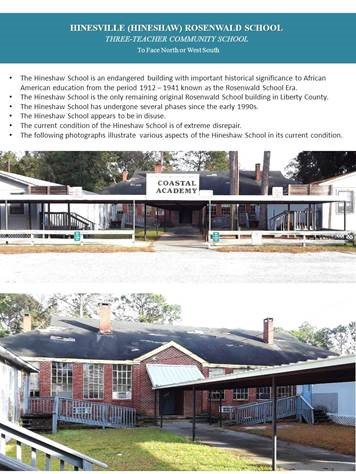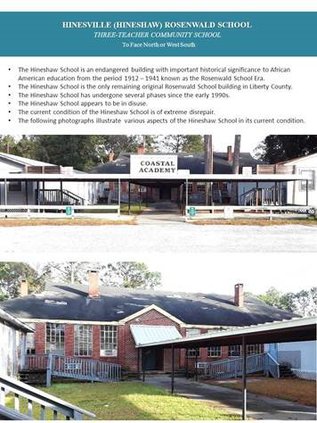The new Class Is In Session exhibit at the Liberty County High School Museum explores the continuity of African American education in Liberty County including the Rosenwald School era and its last remaining building – Hinesville Shaw (Hineshaw) Colored School. Since the period of Reconstruction through the turn of the twentieth century into the Civil Rights Movement era, African American communities throughout the South have long been proponents of quality education for their children despite the 1896 Supreme Court decision Plessy v. Ferguson which upheld “separate but equal.” This is no less true for citizens in Liberty County.
In 1912, Jewish philanthropist and president of Sears & Roebuck Julius Rosenwald joined with Booker T. Washington, president of Tuskegee Normal and Industrial Institute (now Tuskegee University) to develop a campaign to improve public education for African Americans in rural towns throughout the American South. The Rosenwald Fund supported the construction of more than 5,000 schools from Maryland to Texas. In the state of Georgia two hundred forty-four schools were built in rural counties and Liberty County can boast of having supported this effort with the building of four Rosenwald Schools: Trinity School (1921-1922), Cross Roads School/ County Training School (1928-1929), Cross Roads Industrial Shop (1930-1931), and the Hinesville Shaw School (1930-1931).
According to the January 6, 1931 Liberty County School Board of Education minutes, the colored patrons of the Hinesville and Flemington Colored Schools petitioned the Board to authorize a committee to investigate a suitable location in which to construct a Rosenwald School. Twenty-eight days later, on February 3, 1931, leaders of the Trustees of the Hinesville Colored School which included John H. Gause, Alonzo Simpson, and F. L. Duggan sold a two-acre tract to the Board of Education for one hundred dollars. The site of the proposed new school was bound by property belonging to Rebecca Shipman on the east, Eddie Shipman to the south, Little Bethel Church to the west, and land owned by O. J. Olmstead to the North. By February 28, 1931 the deal was finalized as outlined in the Liberty County Clerk of Court records.
The historic African American community nestled to the east of downtown Hinesville thrived for decades prior to the installation of Fort Stewart in 1941. 1920 U.S. Census data indicates that the working class community consisted of residents who were land owners and hardworking laborers in the turpentine and logging industry. There were a few teachers. There was a store, barber shop, masonic hall, several churches, and a simple schoolhouse.
Liberty County’s Last Remaining Rosenwald School
By the 1930s what residents in the community desired most was an adequate place to educate their children. In the 1930-1931 budget year, the Hineshaw Rosenwald School, a three-teacher brick Rosenwald, was constructed on Gause Street at the cost of $2,300. The Rosenwald Fund contributed $400 as well as the professional architectural plans while the African American community contributed $400 and the public $1,500. Hineshaw is the last remaining Rosenwald School in Liberty County.
Living Memories
Today there are only five living students who attended the Hineshaw School during the Rosenwald era: Henry Baker, Edna Mae Anderson Miller, Lula Pearl Henry, Ernestine Jackson Taylor, and Cornelia Hargrove Jones. They have fond memories of their experiences as students. 90 year-old Ernestine Taylor is a former student. The aunt of District 5 Commissioner Gary Gilliard, Taylor attended the school when her family moved to Hinesville from Tatnall County in 1942.
“The school was made of brick and it had several rooms,” Taylor said. “It had grades one through seven. I completed 6th and 7th grades when I came here. My teachers were Mrs. Ophelia Futch, Mrs. Wilhemina Jasper, Mrs. Willie Louise Quarterman, and Mrs. Tarver who was the wife of Principal Henry Tarver. We had a good time in school. I was pretty smart. I can remember winning the Spelling Bee over everybody else. The first gift I ever received in my life was for reciting a poem by Paul Laurence Dunbar. I won a suitcase. There were no buses and we walked to school each day. I recall we had a soup kitchen and a basketball court. I played basketball. We were not [integrated]. We were all one color.”
Tyrone Simpson (73) lives in New Jersey. He attended the Hineshaw Rosenwald School in the early 1950s. Alonzo Simpson was his grandfather.
“The community on Gause Street facing the school was called Dog Alley and there were businesses,churches, and a cafe called the Blue Moon Café,” Simpson said. “Hineshaw was important to our community. I had no idea that my grandfather was instrumental in this school-building process,”
Carolyn Smith-Carter, a retired Liberty County educator, is the daughter of Romena Shipman Smith (deceased), a former student of Hineshaw. She has her mother’s report card from the Rosenwald days.
“My mother attended Hineshaw Rosenwald School until ninth grade,” Smith-Carter said. “The classrooms at the school was heated by a wooden stove that, according to my mother, sat in the middle of the classroom and students had to take turns warming their hands and feet by the stove in the winter. After ninth grade mother attended Dorchester Academy until the tenth grade. She could have gone further but she had to work to pay for her hospitalization for a ruptured appendices.”
Hineshaw Rosenwald School meets the 11 Most Endangered Places List
In 2002, the National Trust for Historic Preservation placed the Rosenwald Schools on its 11 Most Endangered Places List. Across Georgia many African Americans of that generation have formed friends groups and obtained ownership of their former schoolhouses to preserve that special moment in the history of Black education in the south. The Hineshaw Rosenwald School building operated under the auspices of Liberty County Board of Education for nearly seventy years and closed its doors in the early 1990s. It is apparent that the building is no longer in use as it lies in utter disrepair.
Preserving Place
Smith-Carter, County Commissioner Gary Gilliard, and a group of former students would like to preserve the school as it is the last remaining vestige of the Rosenwald School era in all of Liberty County.
“There are other existing Rosenwald schools in Georgia that are in poor condition including one that only has the foundation and friends of that school have preserved the site and made it a park. They understand the significance of the site in regard to African American history and culture. If there is support to preserve a memory of a non-existing building, then surely the powers that be in Liberty County can see the importance of preserving the Hineshaw Rosenwald School which has so much more in terms of the original Rosenwald architecture and means so much in terms of the history of education in Liberty County.”
The Rosenwald Exhibit will be on display at the Liberty County High School Museum throughout the month of December. The museum is located at 9397 E. Oglethorpe Highway in Midway. It is open to the public on Tuesdays and Thursdays from 11 a.m. – 2 p.m.

